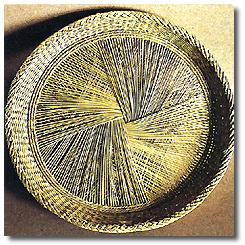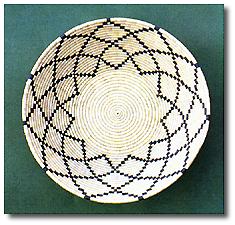In Planargia, Flussio, Montresta and
Tinnura and in Ollolai and Olzai in Barbagia, the basket makers follow the most ancient tradition
and use asphodel which is the most elastic and strong plant in Sardinia.
The asphodel, dried and
cut into strips, is clear colored on one side and darker on the other which allows the craftswomen
to create sophisticated geometrical designs utilizing the two natural tints.
In Romangia, Sennori,
Sorso, Anglona, Castelsardo and Tergu the dwarf palm, that grows behind the sand dunes, and raffia
are most widely used.
|
|

|

|
|
The baskets from Castelsardo, which are
perhaps the most famous among Sardinian baskets are also the baskets that deviate most from
traditional designs. These changes are due both to external influences and to the fact that finding
the raw material is getting more and more difficult.
It is these baskets that are under threat
from factory produced imitations, from the scarce supply of raw materials, from an aging work force
and low profits. In fact there is a danger that the craftswomen who produce these beautiful baskets
will disappear in one or two generations.
|
Finally we would like to mention the
wicker baskets, usually with handles, which are made by farmers and shepherds. These baskets are
made from osier, oleaster and reed. The shapes of the baskets depend on what they are designed to be
used for. They are made in various villages in the Sassari area, in Gallura, in Bosa, in Tirso and in
the Campidano valley.
|
|